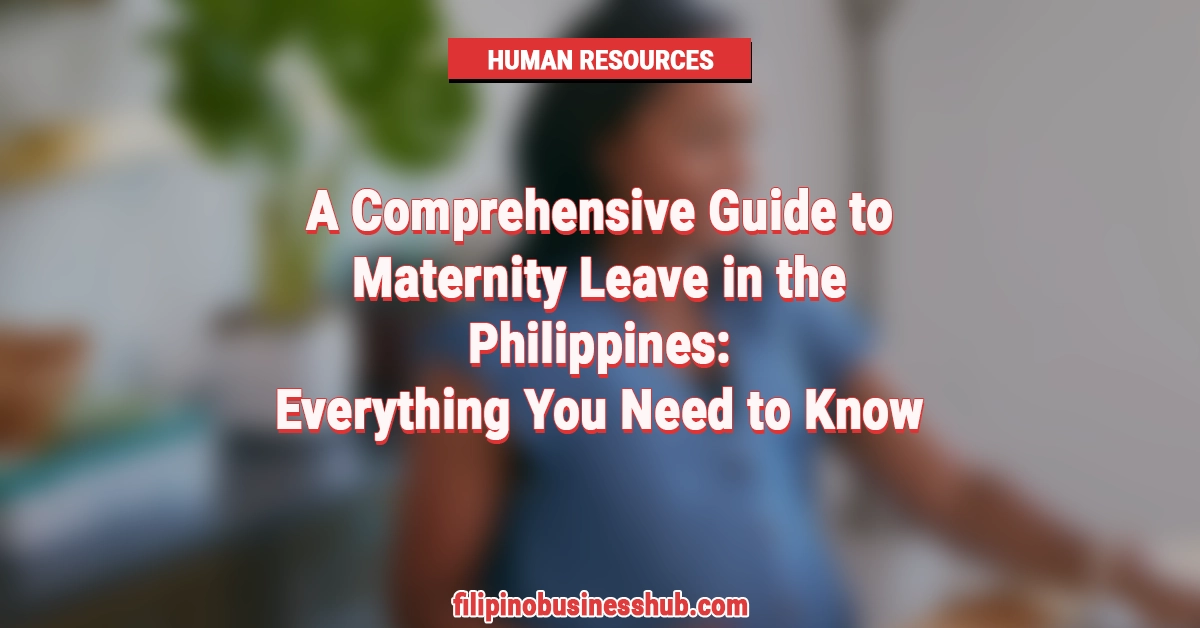A Comprehensive Guide to Maternity Leave in the Philippines: Everything You Need to Know
Maternity leave is an integral component of employment that acknowledges and meets the special needs of working mothers during a significant life event like childbirth. Maternity leave provides valuable time off from work so working mothers can recover after labor, bond with their newborns, and adjust to motherhood’s demands. This benefit has also become legally protected in the Philippines through various laws and regulations.
Philippines lawmakers have recognized working mothers’ essential roles in their households and workplaces. Maternity leave laws help support and safeguard these working mothers’ rights while creating a healthier work-life balance.
This comprehensive guide will delve into all aspects of maternity leave in the Philippines. We will examine its significance to working mothers during this transformative time and highlight its physical, emotional, and psychological advantages during a transformative period. Understanding its significance helps foster an inclusive work environment that values the well-being of working mothers.
Additionally, we will present an overview of maternity leave laws in the Philippines, detailing legal provisions and rights offered to employees. This overview is a foundation for better comprehending what working mothers can expect when taking maternity leave.
Join us as we navigate the Philippines’ complex landscape of maternity leave, arming working mothers with the knowledge and insight to make informed decisions regarding their maternity leave rights by spreading awareness and creating an atmosphere that supports working mothers during motherhood while upholding professional aspirations simultaneously.
Table of Contents
Maternity Leave in the Philippines
Definition and Purpose of Maternity Leave
Maternity leave is a period granted to working mothers after giving birth to provide physical recovery, bonding with their newborn, and adjusting to motherhood. Maternity leave is an invaluable support system that recognizes their special needs and challenges during postpartum. Maternity leave allows mothers to prioritize their health and their newborn’s welfare during this critical transition phase to ensure an effortless parenthood journey.
Legal Provisions and Rights of Employees
In the Philippines, maternity leave is legally defined through Republic Act No. 11210 or “Expanded Maternity Leave Law,” known by its acronym EMLL. This legislation was created to offer greater protection and benefits for working mothers; under this legislation, female employees can take a set number of days of leave with associated benefits.
The Expanded Maternity Leave Law offers qualified female employees up to 105 days of maternity leave, comprising 60 for normal delivery and 72 days for cesarean. Furthermore, an optional extension of 30 days without pay may add another 45 days bringing total maternity leave entitlement up to 135 days.
Coverage and Eligibility Criteria
Maternity leave coverage extends to all female public and private employees, regardless of their employment status, whether regular, probationary, project-based employees, seasonal workers, or those working in informal sectors. Furthermore, self-employed women who are Social Security System (SSS) members also qualify for these benefits.
To be eligible for maternity leave benefits, a female employee must have contributed at least three monthly amounts to Social Security during the 12 months immediately preceding her childbirth or miscarriage semester. Employers should inform Social Security of this application for leave.
Understanding coverage and eligibility criteria are key for employees and employers to comply with the law and support the transition into maternity leave for working mothers.
By upholding legal provisions and acknowledging employees’ rights, the Philippines maternity leave system seeks to safeguard and support working mothers for a healthier work-life experience, ultimately contributing to overall family welfare.
Maternity Leave Letter
Importance and Purpose of a Maternity Leave Letter
A maternity leave letter is a formal communication that a pregnant employee sends to their employer to inform them about their intention to take maternity leave. It serves as an essential document that establishes a clear understanding between the employee and the employer regarding the leave duration and ensures proper arrangements are made to cover the employee’s responsibilities during their absence.
The maternity leave letter is crucial in facilitating a smooth transition and ensuring the employer knows the employee’s plans. It allows the employer to make necessary arrangements, such as finding a temporary replacement or redistributing the workload, to maintain operational efficiency in the workplace.
Essential Information to Include
When writing a maternity leave letter, it is important to include the following essential information:
- Employee’s name and position: Begin the letter by clearly stating the employee’s full name and current position in the company.
- Date of the letter: Include when the letter is written to establish a record of communication.
- Expected Date of childbirth: Specify the anticipated Date of childbirth to provide the employer with an understanding of the timeline for the maternity leave.
- Duration of maternity leave: Clearly state the intended duration, including the start date and the anticipated return date.
- Contact information: Provide updated contact information, such as phone number or email address, where the employer can reach the employee during the maternity leave period if necessary.
- Intentions regarding work tasks: Express any preferences or intentions regarding work tasks during the maternity leave, such as delegating responsibilities or providing guidelines for temporary replacements.
Sample Format and Tips for Writing an Effective Maternity Leave Letter
Here is a sample format for a maternity leave letter:
[Employee’s Full Name]
[Employee’s Position]
[Company Name]
[Company Address]
[City, State, ZIP Code]
[Date]
Dear [Employer’s Name],
I am writing to inform you of my intention to take maternity leave under the company’s policies and the provisions of the applicable maternity leave laws. I am expecting the birth of my child on [Expected Date of Childbirth].
I plan to commence my maternity leave on [Start Date] and anticipate returning to work on [Anticipated Return Date]. The duration of my maternity leave will be [Number of Weeks] weeks.
During my absence, I request your support in making the necessary arrangements to ensure the smooth continuation of work. I have taken the initiative to prepare detailed instructions for my colleagues regarding ongoing projects and tasks that may require attention during my absence. Additionally, I am more than willing to assist in training a temporary replacement if necessary.
Should there be any urgent matters or important updates during my maternity leave, you can reach me via email at [Email Address] or by phone at [Contact Number].
I would like to express my gratitude for your understanding and support during this significant time. I am committed to making a seamless transition and returning to work with renewed dedication and enthusiasm.
Thank you for your attention to this matter.
Sincerely,
[Employee’s Full Name]
Tips for Writing an Effective Letter:
- Keep the tone professional and concise.
- Submit the letter well in advance, allowing the employer sufficient time to plan for your absence.
- Seek clarity regarding the company’s specific policies and procedures for maternity leave, and adhere to them in your letter.
- Maintain open communication with your employer throughout the process and be prepared for any necessary discussions or negotiations regarding the terms of your maternity leave.
- Proofread the letter for grammar, spelling, and clarity before submitting it to your employer.
Writing a well-crafted maternity leave letter ensures that both you and your employer are on the same page regarding the details of your leave, fostering a supportive and
Implementing Rules and Regulations (IRR) of Maternity Leave
Understanding the IRR and Its Significance
The Implementing Rules and Regulations (IRR) of maternity leave in the Philippines provide detailed guidelines and specific provisions that supplement the existing laws governing maternity leave. The IRR is a crucial document that clarifies the practical application and implementation of maternity leave laws, ensuring consistency and uniformity in their execution.
The IRR plays a significant role in ensuring that employers and employees understand their rights and responsibilities related to maternity leave. It clarifies various aspects such as eligibility criteria, computation of benefits, notification procedures, and other relevant details necessary for the proper implementation of maternity leave.
Key Provisions and Guidelines
The IRR of maternity leave in the Philippines includes important provisions and guidelines that employers and employees must adhere to. These provisions cover a wide range of aspects, including but not limited to:
- Eligibility criteria: The IRR outlines the requirements that employees must meet to be eligible for maternity leave benefits, such as the minimum number of contributions to the Social Security System (SSS) and the timeframe for these contributions.
- Duration of maternity leave: It provides clear guidelines regarding the duration of maternity leave, distinguishing between basic and additional leave for those who undergo cesarean delivery.
- Computation of benefits: The IRR specifies the computation method for maternity leave benefits, including calculating the average daily salary and the corresponding monetary benefits employees are entitled to.
- Notification procedures: It outlines the policies and timelines for notifying the employer about the employee’s intention to take maternity leave, as well as the supporting documents required to process benefits.
- Protection against discrimination and retaliation: The IRR emphasizes the prohibition of discrimination or retaliation against employees exercising their maternity leave rights, safeguarding their employment security, and ensuring a fair and inclusive work environment.
Recent Updates and Amendments
The IRR of maternity leave in the Philippines undergoes periodic updates and amendments to align with changing societal needs and evolving legal frameworks. These updates may incorporate changes in eligibility criteria, benefits computation, or procedural requirements, among other aspects.
Staying informed about the recent updates and amendments to the IRR is crucial for employers and employees to ensure compliance with the latest regulations. It is recommended to regularly check for any official announcements, circulars, or revisions issued by relevant government agencies to remain up-to-date with the current guidelines and provisions.
Counting 105 Days of Maternity Leave
Calculation Methodology for Maternity Leave Duration
When counting the 105 days of maternity leave in the Philippines, it is essential to understand the calculation methodology. The duration of maternity leave is determined based on the provisions of the Expanded Maternity Leave Law and its implementing rules and regulations.
To calculate the maternity leave duration, the following factors are considered:
- Type of delivery: The delivery does not affect the maternity leave duration in the Philippines. Whether the employee undergoes expected delivery or a cesarean section, the entitlement to maternity leave remains the same. The law grants 105 days of maternity leave to all eligible female employees, providing them with sufficient time to recover from childbirth, bond with their newborn, and adjust to the demands of motherhood. This ensures equal benefits and support for all mothers, irrespective of their mode of delivery.
- Continuous leave: The maternity leave is counted as a continuous period, starting from the actual delivery date or the date the employee begins the leave, whichever comes first. The leave duration does not include the prenatal period before the actual delivery.
Understanding the Start and End Dates
To determine the start and end dates of the maternity leave, it is crucial to consider the actual delivery date or the chosen start date, considering the expected delivery date provided by healthcare professionals. The employee should inform the employer of the intended start date, following the notification procedures outlined in the relevant laws and regulations.
Factoring in Rest Days, Holidays, and Absences
When counting the 105 days of maternity leave, it is essential to consider rest days, holidays, and any absences during the period. The maternity leave duration includes Rest days and holidays and should not be deducted from the total count. This means the employee will still enjoy their regular rest days and holidays during maternity leave.
However, any absences taken by the employee during the maternity leave period, such as sick or vacation leave, are not considered part of the maternity leave and should be accounted for separately. These additional absences do not extend the duration of the maternity leave beyond the specified 105 days.
By understanding the calculation methodology, correctly determining the start and end dates, and considering rest days, holidays, and absences, employees can ensure that they maximize their entitled 105 days of maternity leave while adhering to relevant laws and regulations. It is advisable to consult with the employer or the Human Resources department for any specific guidelines or clarifications regarding counting maternity leave duration.
Filing for Maternity Leave
Preparing the Necessary Documents
Before filing for maternity leave in the Philippines, gathering and preparing the necessary documents is essential. These documents typically include the following:
- Medical certificate: A medical certificate from a licensed healthcare professional stating the expected date of childbirth or actual date of delivery.
- Maternity notification form: This form, often provided by the employer or the Social Security System (SSS), includes personal information, employment details, and other relevant data required for processing maternity benefits.
- Supporting documents: Additional supporting documents may be required, such as a marriage certificate, if applicable, and other documents as specified by the employer or the SSS.
Notifying the Employer and HR Department
Once the necessary documents are prepared, it is crucial to promptly notify the employer and the Human Resources (HR) department about the intention to take maternity leave. The notification should be done in writing and include the expected start date and duration of the leave.
Informing the employer and HR department well in advance allows them to make the necessary arrangements and ensures a smooth transition during the employee’s absence. Following any specific notification procedures outlined by the employer or the company’s policies is recommended.
Procedural Steps and Requirements
The procedural steps and requirements for filing maternity leave may vary depending on the company and the guidelines set by the Social Security System (SSS). However, some common steps include:
Complete the maternity notification form: Fill out the required information accurately and attach the supporting documents as necessary.
- Submit the maternity notification form: Submit the completed form and supporting documents to the HR department or the designated personnel in the company. Ensure you keep a copy of the submitted documents for your records.
- Await confirmation and processing: The HR department or the SSS will process the maternity leave application and verify the eligibility criteria and supporting documents. It may take some time for the application to be reviewed and approved.
- Receive notification and benefits: Once the application is approved, you will receive notification regarding the approved maternity leave and the corresponding maternity benefits. The benefits are typically provided through the SSS, and the payment process may vary depending on the arrangement between the employer and the SSS.
It is essential to comply with the procedural steps and requirements outlined by the employer and the SSS to ensure smooth and efficient processing of the maternity leave application. Regular communication with the HR department or the designated personnel is recommended to stay updated on the application’s progress and address any inquiries or concerns that may arise.
Computing 13th Month Pay with Maternity Leave
To calculate the 13th Month Pay with Maternity Leave, you can refer to our comprehensive article here. This article provides detailed information and step-by-step instructions on how to compute the 13th Month Pay, taking into account the impact of maternity leave on the calculation.
Duration of Maternity Leave in the Philippines
Maternity Leave Duration
The current law in the Philippines grants 105 days of maternity leave to all eligible female employees, regardless of the type of delivery (normal or cesarean section). This extended duration aims to provide mothers ample time to recover from childbirth, establish a bond with their newborn, and adjust to their new roles and responsibilities.
Additional Leave Benefits
In certain circumstances, additional leave benefits may be granted to female employees beyond the 105-day maternity leave. These include extended maternity leave for multiple births (twins or more) and an additional 30 days for female employees who qualify as solo parents under the Solo Parents Welfare Act.
Final Words
Summary of Key Points Covered
In this comprehensive guide to maternity leave in the Philippines, we have covered various aspects and key considerations related to maternity leave. We discussed the definition and purpose of maternity leave, legal provisions and rights of employees, filing procedures, computing 13th Month Pay with maternity leave, duration of maternity leave, and the significance of maternity leave support.
Importance of Maternity Leave Support and Work-Life Balance
Maternity leave is vital in supporting working mothers during a significant phase of their lives. It provides them the necessary time to recover from childbirth, bond with their newborn, and navigate the demands of motherhood. Maternity leave also promotes work-life balance, recognizing the value of family and caregiving responsibilities alongside professional commitments.
Empowering Working Mothers through Maternity Leave Rights
Recognizing and respecting the maternity leave rights of working mothers is essential for fostering an inclusive and supportive work environment. Employers should uphold these rights by adhering to the legal provisions, providing necessary support and resources, and ensuring fair and equal treatment for all employees.
By empowering working mothers through maternity leave rights, we contribute to their overall well-being, career satisfaction, and long-term success. It is a shared responsibility of employers, policymakers, and society to create an environment that values the contributions of working mothers and promotes their well-being.
Maternity leave is a crucial aspect of employment rights in the Philippines, allowing working mothers to balance their personal and professional lives. By understanding the legal provisions, filing procedures, computation methods, and duration of maternity leave, employers and employees can ensure compliance, fairness, and support for working mothers nationwide.
Remember, each journey through maternity leave is unique, and it is crucial to seek guidance from your employer, the Human Resources department, and relevant government agencies for specific information and assistance tailored to your circumstances.
Let us embrace the significance of maternity leave and work together to create a supportive and empowering environment for working mothers in the Philippines.






